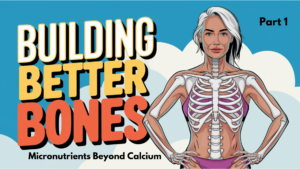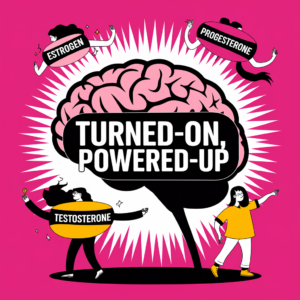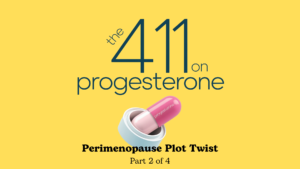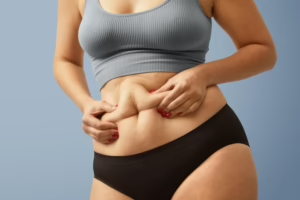like to think of perimenopause as the hormonal rollercoaster that nobody warns you is coming. You’re not alone if you’ve been feeling like your body’s suddenly decided to throw a rager without inviting your brain to the party. Let’s break down this transitional phase and talk about how not just to survive it, but absolutely crush it.
What’s Happening?
Let’s get nerdy for a minute: perimenopause is essentially your body’s gradual transition toward menopause. Your ovaries are starting to slow their production of estrogen and progesterone but in the most chaotic way possible. Imagine your hormones as enthusiastic but increasingly unreliable DJs – some months they’re dropping sick beats, other months they’re knocking over the equipment and setting the turntables on fire.
During this time, your follicle-stimulating hormone (FSH) levels start rising as your body works harder to stimulate those increasingly stubborn ovaries. Meanwhile, your estrogen levels are fluctuating wildly – sometimes plummeting, sometimes surging higher than your pre-peri days. It’s biochemical chaos, and you’re along for the ride.
The Timeline: When Does This Party Start?
Most women enter perimenopause in their mid-40s, but it can start anywhere from your late 30s to early 50s. The average duration is about 4 years, but (surprise!) it can last anywhere from a few months to a decade. Because why make anything simple, right?
For my high achievers who want specifics, the medical community generally considers perimenopause to begin when your menstrual cycles become irregular and continue until you’ve gone 12 consecutive months without a period (that’s official menopause).
The Classic Symptoms: “Is It Hot in Here, or Is It Just My Hormones?”
- Hot flashes & night sweats: Suddenly feeling like you’re standing on the surface of the sun for no apparent reason? Classic peri move. Hot flashes can happen anytime estrogen is fluctuating, which makes it tricky to know whether you need to add estrogen or just need to wait for your E to come back to Earth.
- Sleep disruption: Insomnia, middle-of-the-night wakeups, or the delightful combo of being exhausted all day and wide awake at 3 AM.
- Mood changes: Irritability, anxiety, and mood swings that make your teenage years look emotionally stable.
- Irregular periods: Shorter cycles, longer cycles, heavier flow, lighter flow – it’s like your uterus is just throwing darts at a calendar.
- Vaginal dryness: Because apparently, your body decided that sex should become more challenging just when you’ve finally figured out what you actually want.
- Decreasing fertility: Though pregnancy is still possible! (Yes, you still need birth control. No, perimenopause is not nature’s contraceptive.)
The “Nobody Warned Me About These” Symptoms
- Brain fog: Forgetting words, losing your train of thought mid-sentence, or walking into a room without knowing why you’re there.
- Joint pain: Waking up feeling like you’ve aged 20 years overnight.
- Heart palpitations: That fun fluttery feeling that makes you wonder if you should call 911 or just drink less coffee.
- Changing body composition: Even if the scale doesn’t change, you might notice your fat redistributing (hello, midsection!).
- Reduced collagen production: Suddenly noticing more wrinkles and thinner skin? Blame the estrogen decline.
- Hair changes: Thinning on your head, new growth in places you’d rather not have it. Causes can include loss of estrogen but also low thyroid, low ferritin, stress, and many other perimenopausal-related problems.
- Increased UTIs and yeast infections: Lower estrogen means changes in your vaginal pH, which can mean more infections.
The “How To Peri” Game Plan
Now for the good stuff – how can this transition be smoother than a post-BOTOX forehead?
A. Lifestyle Modifications (The Foundation)
- Nutrition: I’m not about crash diets, but I am about strategic eating:
- Pump up the protein: Aim for 1 gram of protein per pound of ideal body weight daily. Your muscles and metabolism will thank you.
- Fiber is your friend: 25-30g daily to help manage those hormonal mood swings and keep your gut microbiome happy.
- Phytoestrogens: Consider adding soy, flaxseeds, and legumes to your diet. These plant-based compounds can help ease the estrogen rollercoaster.
- Hydrate like your hot flashes depend on it: Because they do. Aim for at least 2-3 liters daily.
- Movement is medicine:
- Daily movement: 30+ minutes of something – anything – that gets your heart rate up (aim for zones 4 and 5 if you track such things).
- Resistance training 3+ days/week: This is non-negotiable, ladies. Muscle mass decreases as estrogen drops, and strength training is your best defense. Plus, it helps with insulin sensitivity and bone density (which starts declining BEFORE periods stop).
- Prioritize recovery: Add yoga, stretching, or mobility work to manage joint pain and stress.
- Sleep hygiene:
- Keep your bedroom cool (around 65°F/18°C)
- Establish a consistent bedtime routine
- Limit screen time before bed
- Consider a cooling mattress pad if night sweats are disrupting your sleep
- Go outside each morning and feast on the morning sun for at least 10 minutes. Trust me – your circadian rhythms love this nature-stuff!
- Stress management:
- Your adrenals are already working overtime during perimenopause, so excessive stress is like pouring gasoline on a hormone fire.
- Find what works for you: meditation, breath work, nature walks, or maybe just setting better boundaries with people who drain your energy.
B. Hormone Therapy: The Strategic Approach
When lifestyle changes aren’t quite cutting it, it’s time to consider some hormone support. Here’s my typical progression:
- Start with progesterone: Often the first hormone to decline, supplementing with progesterone (either cyclically or continuously) can help with sleep, anxiety, and heavy/irregular bleeding. Options include:
- Oral micronized progesterone (100-200mg) before bed. Helps with sleep in 80% of users.
- Vaginal Progesterone: You can put your oral gel caps into the land-down-under if oral progesterone makes you too sleepy or too excited.
- Sublingual Progesterone: This compounded option is great for day-time use as it doesn’t make you sleepy.
- Consider testosterone: Yes, it’s not just for men! Low-dose testosterone can help with energy, libido, brain fog, and muscle maintenance. Options include:
- Creams/gels (typically 3-10mg daily)
- Injections (less common for women but still useful – usually 3-8 mg subcutaneous injection weekly)
- Add estradiol as needed in late perimenopause: As you move closer to menopause and estrogen levels consistently drop, adding estrogen can provide significant relief for symptoms like hot flashes, vaginal dryness, and mood changes. Options include:
- Transdermal patches or creams – multiple doses available
- Vaginal estrogen for localized (vaginal) symptoms – ex: estradiol 0.01% cream or estriol 0.3% cream, 1-2 grams three days/week.
- Oral estradiol (though this increases clotting factors more than transdermal options)
Remember: Hormone therapy should be personalized, regularly monitored, and adjusted based on symptoms and labs. One-size-fits-all approaches are so last century.
C. Biohacks and Tech Solutions: The Cutting Edge
Why not use every tool that is available to us? Some of my favorites:
- Red light therapy: Helps with skin collagen production and may reduce inflammation and stabilize blood glucose levels after eating.
- Peptides: GHK-Cu for skin, BPC-157 for gut health and tissue repair, and Pineleon for sleep support.
- Temperature-regulating mattress covers: Brands like Eight Sleep and Sleep.Me have great options for keeping your bed temperature just right.
- Continuous glucose monitors: Helpful for managing the insulin resistance that can develop during this time.
- Supplement nutritional support: HOP Box (my company) has 19 of my favorite ingredients within easy twice-daily packs. Woot woot! I also love creatine, essential fatty acids, and collagen peptides during perimenopause.
Final Thoughts: You’ve Got This!
Remember that perimenopause is not a disease – it’s a natural transition that every woman experiences. But “natural” doesn’t mean you have to suffer through it! By combining lifestyle optimizations with strategic hormone support and innovative technologies, you can navigate this phase with grace and power and maybe even enjoy the journey.
The best approach is personalized, proactive, and positive. Work with a healthcare provider who takes your symptoms seriously (ahem, like me) and isn’t afraid to try different approaches until you find what works for you.
And hey – perimenopause might be challenging, but it’s also an opportunity to reconnect with your body, reinvent your approach to health, and step into the next phase of your life stronger and more vibrant than ever before.
You’ve got this!
Dr. ABK
References:
- Santoro N. Perimenopause: From Research to Practice. J Womens Health (Larchmt). 2016;25(4):332-339.
- Lobo RA. Hormone-replacement therapy: current thinking. Nat Rev Endocrinol. 2017;13(4):220-231.
- Mishra N, Mishra VN, Devanshi. Exercise beyond menopause: Dos and Don’ts. J Midlife Health. 2011;2(2):51-56.
- Kapoor E, Collazo-Clavell ML, Faubion SS. Weight Gain in Women at Midlife: A Concise Review of the Pathophysiology and Strategies for Management. Mayo Clin Proc. 2017;92(10):1552-1558.
- Davis SR, Wahlin-Jacobsen S. Testosterone in women—the clinical significance. Lancet Diabetes Endocrinol. 2015;3(12):980-992.
- Gordon JL, Rubinow DR, Eisenlohr-Moul TA, Xia K, Schmidt PJ, Girdler SS. Efficacy of Transdermal Estradiol and Micronized Progesterone in the Prevention of Depressive Symptoms in the Menopause Transition: A Randomized Clinical Trial. JAMA Psychiatry. 2018;75(2):149-157.













